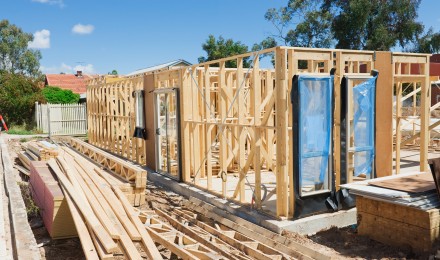One of the major impediments to a turnaround in the U.S. economy has been the plummeting value of home prices across the country. Home prices declined an average of 34% from the peak established in July 2006. Home sales are also at 2006 levels. However, the June release of the Standard & Poor’s/Case-Shiller Home Price Index reveals home prices increased in an average of 1.3% on an unadjusted basis from March to April across the nation.
The seasonally adjusted basis increased 0.7 percent. This represents the first monthly gain in home values since the fall of 2011. Bloomberg News economists had a consensus rate of 0.4 percent. Although it’s a one-month trend, the increase signifies the home market may have reached the long-awaited bottom and is starting to rebound.
Broad Based Gains Shown
The chairperson of the S&P Index committee David M. Blitzer said that such “broad-based gains have not been seen in a long time.” In fact, the combination of rising positive monthly index levels and improving annual returns is a good sign.” However, home prices remain 1.9 percent lower than this time last year. Nonetheless, the index rose after a 2.6 percent decline in March. From March to April, the 10-City and 20-City Composites increased 1.3 percent.
Both indices recorded improvements in the annual rate of returns, posting rates of -22% and -1.95, which Blitzer characterizes as “a good sign. The rates came in lower than annual figures posted in March, -2.9% and -2.6 %, respectively.
The cities with the largest month over- month gains were Phoenix (2.3%), Minneapolis (1.3%), San Francisco (1.5%), Washington D.C. (1.4%), Tampa (1.4%) and Miami (1.2%).
The following table summarizes April 2012 the data for the 20 Metropolitan Statistical Areas.
Detroit posted the only month–to-month decline with a drop of -2.1%. New York loss ground in April compared to March, suffering a -0.1% decline in home prices.
Future Expectations
According to the Wall Street Journal, the next few S&P Case-Shiller reports should present even better news for two reasons:
- The inventory of homes is lower than at any point since 2010. A combination of decreasing supply and increasing demand will exert more upward pressure on home prices. The tight supply has created “bidding wars” among homebuyers in some cities. Have experience bidding wars among homebuyers.
- The number of distressed property sales – foreclosures and short sales has declined. In May, distressed sales made up 25 percent of sales, according to the National Association of Realtors. In April, foreclosures and short sales represented 28 percent of total sales and 31 percent compared to May 2011.
The NAR reports foreclosures sold at an average discount of 19 percent below market value in May. Short sales sold at prices 14 percent less than similar homes. In California, distressed sales dropped to a 4 ½-year low in May, as reported by the firm DataQuick.
The WSJ sees home price data getting better for the rest of the summer building on the early data from the Case- Shiller Home Price Index. Home values could start to retreat in the fall if inventories increase and potential homebuyers move back to the sidelines.
One of the major impediments to a turnaround in the U.S. economy has been the plummeting value of home prices across the country. Home prices declined an average of 34% from the peak established in July 2006. Home sales are also at 2006 levels. However, the June release of the Standard & Poor’s/Case-Shiller Home Price Index reveals home prices increased in an average of 1.3% on an unadjusted basis from March to April across the nation.
The seasonally adjusted basis increased 0.7 percent. This represents the first monthly gain in home values since the fall of 2011. Bloomberg News economists had a consensus rate of 0.4 percent. Although it’s a one-month trend, the increase signifies the home market may have reached the long-awaited bottom and is starting to rebound.
Broad Based Gains Shown
The chairperson of the S&P Index committee David M. Blitzer said that such “broad-based gains have not been seen in a long time.” In fact, the combination of rising positive monthly index levels and improving annual returns is a good sign.” However, home prices remain 1.9 percent lower than this time last year. Nonetheless, the index rose after a 2.6 percent decline in March. From March to April, the 10-City and 20-City Composites increased 1.3 percent.
Both indices recorded improvements in the annual rate of returns, posting rates of -22% and -1.95, which Blitzer characterizes as “a good sign. The rates came in lower than annual figures posted in March, -2.9% and -2.6 %, respectively.
The cities with the largest month over- month gains were Phoenix (2.3%), Minneapolis (1.3%), San Francisco (1.5%), Washington D.C. (1.4%), Tampa (1.4%) and Miami (1.2%).
The following table summarizes April 2012 the data for the 20 Metropolitan Statistical Areas.
Detroit posted the only month–to-month decline with a drop of -2.1%. New York loss ground in April compared to March, suffering a -0.1% decline in home prices.
Future Expectations
According to the Wall Street Journal, the next few S&P Case-Shiller reports should present even better news for two reasons:
- The inventory of homes is lower than at any point since 2010. A combination of decreasing supply and increasing demand will exert more upward pressure on home prices. The tight supply has created “bidding wars” among homebuyers in some cities. Have experience bidding wars among homebuyers.
- The number of distressed property sales – foreclosures and short sales has declined. In May, distressed sales made up 25 percent of sales, according to the National Association of Realtors. In April, foreclosures and short sales represented 28 percent of total sales and 31 percent compared to May 2011.
The NAR reports foreclosures sold at an average discount of 19 percent below market value in May. Short sales sold at prices 14 percent less than similar homes. In California, distressed sales dropped to a 4 ½-year low in May, as reported by the firm DataQuick.
The WSJ sees home price data getting better for the rest of the summer building on the early data from the Case- Shiller Home Price Index. Home values could start to retreat in the fall if inventories increase and potential homebuyers move back to the sidelines.







